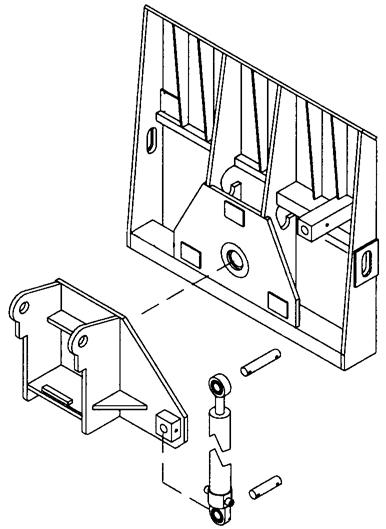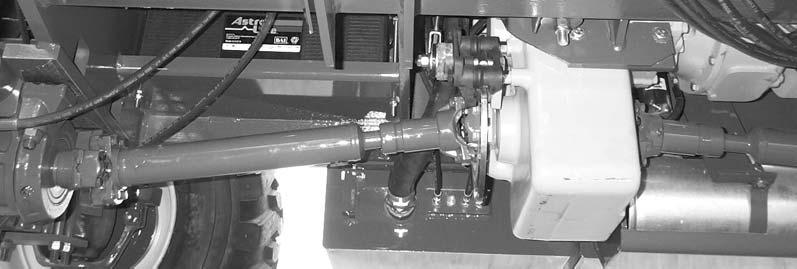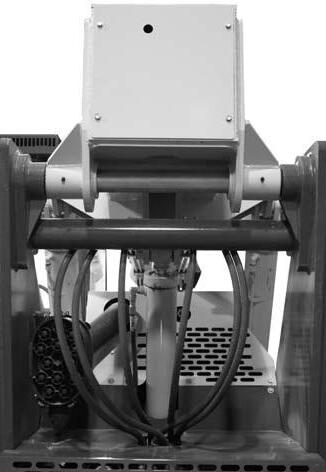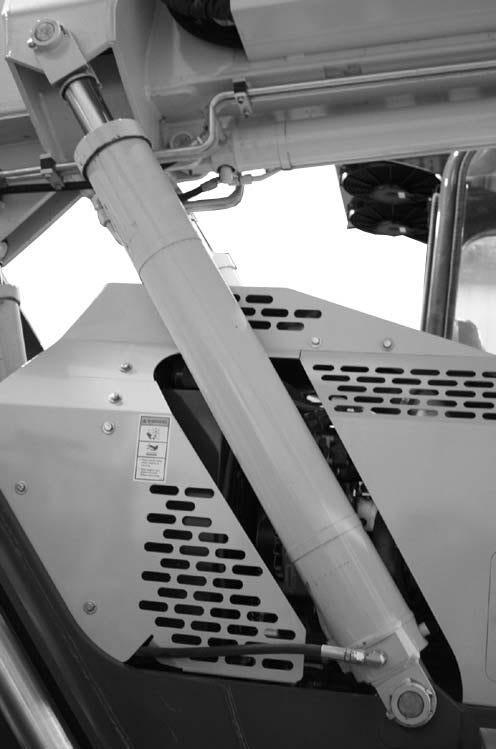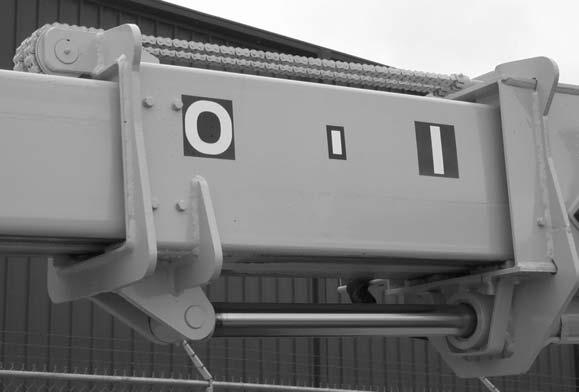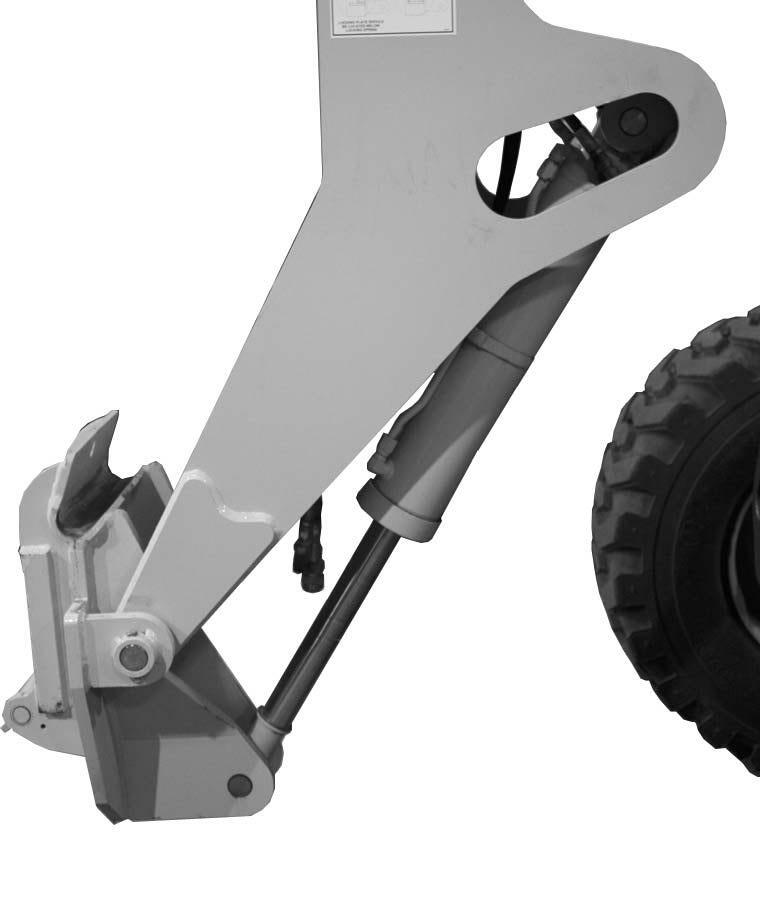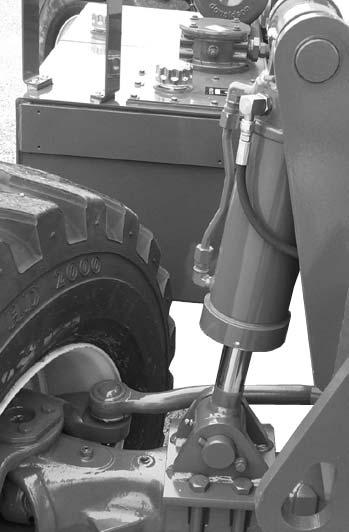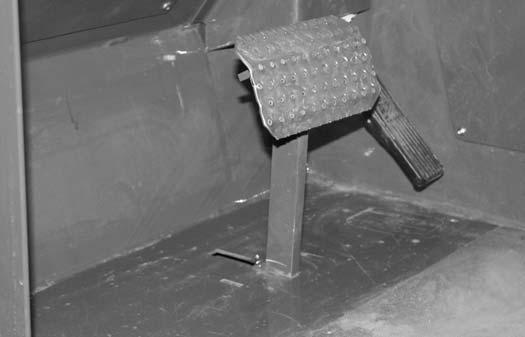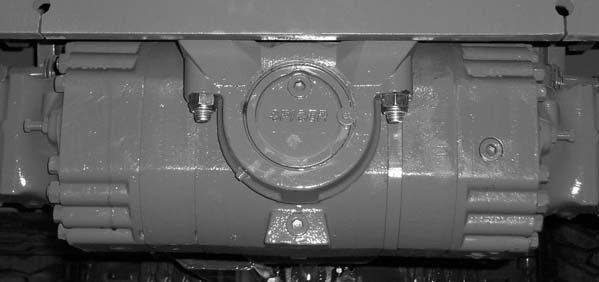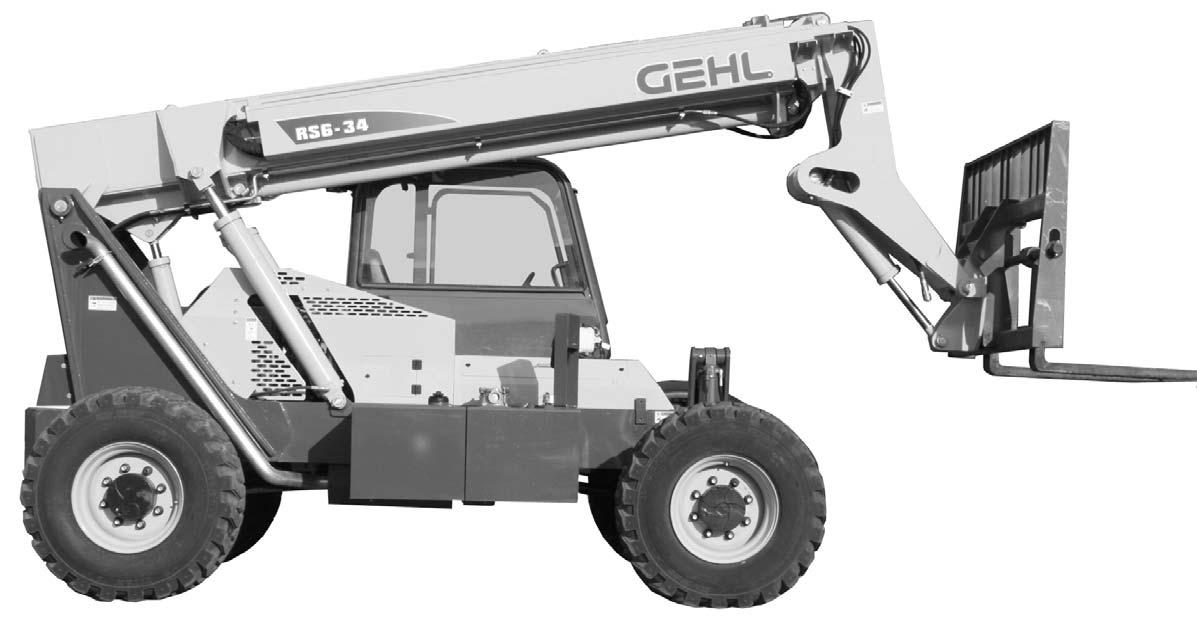
27 minute read
Pre-Start Walk-Around Inspection Illustration
PRE-START WALK-AROUND INSPECTION PROCEDURE
Refer to the following illustration and checklist to perform the inspection. Begin with item 1 at the left front of the machine and walk toward the rear of the machine on the left side and around the back and toward the front on the right side of the machine.
Any needed repairs or service noted during the inspection must be performed by a qualified service technician before operating the machine.
The illustration and checklist page can be copied for future pre-start walk-around inspections.
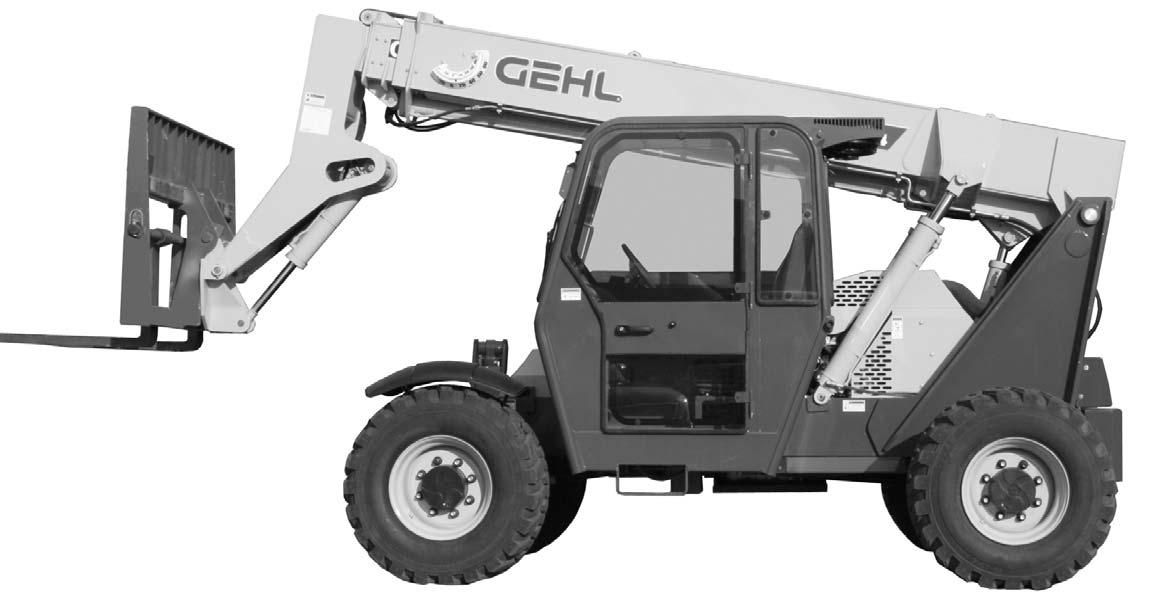
Pre-Start Walk-Around Inspection Checklist
Note the condition of safety decals during the walk-around inspection. Replace missing or illegible safety decals.
o1.Attachment Tool: Check for broken, missing or damaged parts. When using a personnel work platform, check to see if the platform meets ANSI/ITSDF standards and that it is secured to the forks and fork carriage. When using forks, check for welds, cracks or misalignment. Replace the forks in sets when the condition of the forks is questionable.
IMPORTANT: DO NOT use forks that have been repaired by welding.
o2.Attachment Tool Mount: No loose or missing parts; no visible damage.
o3.Attachment Tool Mounting Pins: No visible damage; pin fit is secure and properly lubricated.
o4.Boom Chain: No loose or missing parts; no visible damage; sheave pin fit is secure and properly lubricated.
o5.Boom Sections and Wear Pads: No loose or missing parts; no visible damage or excessive wear.
NOTE: Wear pads that measure 3/8” (9.5 mm) thick or less need to be replaced.
o6.Boom Angle Indicator: Properly secured; no visible damage; bubble is visible.
o7.Tire and Wheel Assemblies: Properly secured; no loose or missing lug nuts; no visible tire damage (cuts or abrasions); proper inflation.
o8.Front and Rear Axles: No loose or missing parts; no visible damage; tie rod end studs locked; no evidence of leaking; properly lubricated.
o9.Operator Compartment: o Seat belt undamaged; operates properly; mounting hardware secure. o Switches and levers undamage; o no loose or missing parts; o load charts properly secured and legible; o levers and switches operate properly; control markings legible; o frame level indicator secured and undamaged, bubble is visible. o10.Lift Cylinder: Properly secured; no visible damage; no evidence of leaking from the cylinder; properly lubricated. o11.Slave Cylinder: Properly secured; no visible damage; no evidence of leaking from the cylinder; properly lubricated. o12.Boom Pivot Assembly: Properly secured; no visible damage or excessive wear; properly lubricated. o13.Boom Hydraulic Hoses: No visible damage or exterior wear; no evidence of leaking. o14.Rear Light Assembly: Properly secured; no visible damage; no loose or disconnected wires; no malfunctions. o15.Hydraulic Control Valve Assembly: No loose or missing parts; no evidence of leaking; no damaged or leaking hoses. o16.Exhaust System: No loose or missing parts; no visible damage; no obstructions to the outlet. o17.Engine Air Filter: No loose or missing parts; no visible damage; no obstructions to the evacuator; precleaner free from dirt; restriction indicator proper reading. o18.Boom Hose Guards: Properly secured; no visible damage. o19.Engine Compartment: o Engine oil level, add if needed; o Coolant level, add if needed; o No evidence of engine oil or coolant leaks; o Belts and hoses in good condition, properly secured and adjusted o20.Fuel Tank: No visible damage; no evidence of leaking; level of fuel; breather cap secure and working. o21.Hydraulic Oil Reservoir: No visible damage; no evidence of leaking; recommended oil level; breather cap secure and working. o22.Battery Compartment (under cover): Proper electrolyte level; no loose or damaged cables; no visible damage or corrosion. o23.Mirror Assembly: No loose or missing parts; no visible damage; properly adjusted. o24.Cowling and Latches: All cowling, doors and latches in working condition; properly secure; no loose or missing parts; all components operate properly. o25.Frame: No visible damage; no cracked welds; no loose or missing parts. o26.Frame Tilt Cylinder: Properly secured; no evidence of leaking; properly lubricated. o27.Tilt and Auxiliary Hydraulic Hoses: No visible damage or excessive wear; no evidence of leaking. o28.Attachment Tilt Cylinder: Properly secured; no visible damage; no evidence of leaking from the cylinder; properly lubricated.
Before Starting Engine
Before mounting the operator’s compartment, walk completely around the machine to be sure no one is under, on, or close to it. Let others in the area know you are going to start up. Wait until everyone is clear of the machine before starting it up.
Before starting the engine and running the machine, refer to the Indicators and Controls chapter and become familiar with the various operating controls, indicators and safety features.
Starting The Engine
Warning
ALWAYS fasten your seat belt BEFORE starting the engine. Leave the parking brake applied until the engine is running and you are ready to operate the machine.
The following procedure is recommended for starting the engine:
1.Grasp the handholds and step up into the operator’s compartment.
2.Adjust the seat and fasten the seatbelt.
3.Check that all controls are in their “neutral” positions, except the parking brake switch, which should be in the “ON” position.
4.Turn the key switch clockwise one position to the “ON” position. When the pre-heat indicator lamp in the multi-function display goes out, the engine can be started.
5.Turn the key switch clockwise until the engine starter activates. Release the key switch when the engine starts. If the key switch is released before the engine starts, turn the key switch to the “OFF” position and wait one minute before attempting to start again.
IMPORTANT: Crank the starter until the engine starts. If the engine fails to start within 20 seconds, return the key to the “OFF” position, wait one minute, and try to start the engine. Cranking the engine for longer than 20 seconds will result in premature failure of the starter.
6.After the engine starts, allow several minutes warm-up time before operating the controls. Allow a longer warm-up time in cold weather.
7.Check that indicators are in their normal operating conditions.
8.Verify that there are no fuel, oil or engine coolant leaks, and no abnormal noises or vibrations.
Cold Starting Procedures
The engine is equipped with a block heater. This block heater or other starting aid is required for starting in temperatures below 32°F (0°C). See your Gehl dealer for additional starting aids.
Warning
Do not use starting fluid (ether) with engine glow plug preheat systems. An explosion can result, which can cause engine damage, injury or death.
If the battery becomes discharged and has insufficient power to start the engine, jumper cables can be used for starting assistance. Refer to the jump starting instructions in the Service and Storage chapter of this manual for safe jump starting procedures.
Stopping
The following procedure is the recommended sequence for stopping the machine:
1.Bring the machine to a stop on a level surface. Avoid parking on a slope, but if necessary park across the slope and block the wheels.
2.Fully retract the boom and lower the attachment to the ground.
3.Idle the engine for at least 2 minutes for gradual cooling.
4.Place controls in neutral. Apply the parking brake.
5.Turn the ignition switch key to the “OFF” position. Remove the key.
6.Unfasten the seatbelt, and grasp the handholds while climbing out of the operator’s compartment.
First Time Operation
Make sure the engine is warm, and then go through the following procedures:
Caution
Be sure the area used for test-running is clear of spectators and obstructions. Initially, operate the machine with an empty attachment tool.
Place the travel lever in Forward or Reverse and select a speed range. Switch off the parking brake and move ahead slowly, while testing the steering and brakes. Stop and operate all boom, attachment tool functions and frame leveling controls, checking for smooth response.
Apply the service brakes, stop the machine and move the travel lever to the opposite direction (forward or reverse).
Shifting to the next higher gear may be done at any engine speed while the machine is in motion.
DO NOT overspeed the engine when down-shifting. Allow the machine to slow down before shifting to the next lower gear.
Engine Shutdown Protection
The engine is equipped with a WARNING and SHUTDOWN feature to warn of critical engine related fault errors. These fault errors will be displayed in the multifunction display. If the cause of the error code is not corrected, the engine power will be reduced automatically, or the engine will shut down.
Parking Brake
NOTE: The parking brake mechanism within the front axle is not designed for, and not intended to be used as, the primary means of stopping movement of the machine. Hydraulic braking provided through the service brakes within the axles is the primary means for stopping movement. The axleby-axle split brake system is the secondary means of stopping movement.
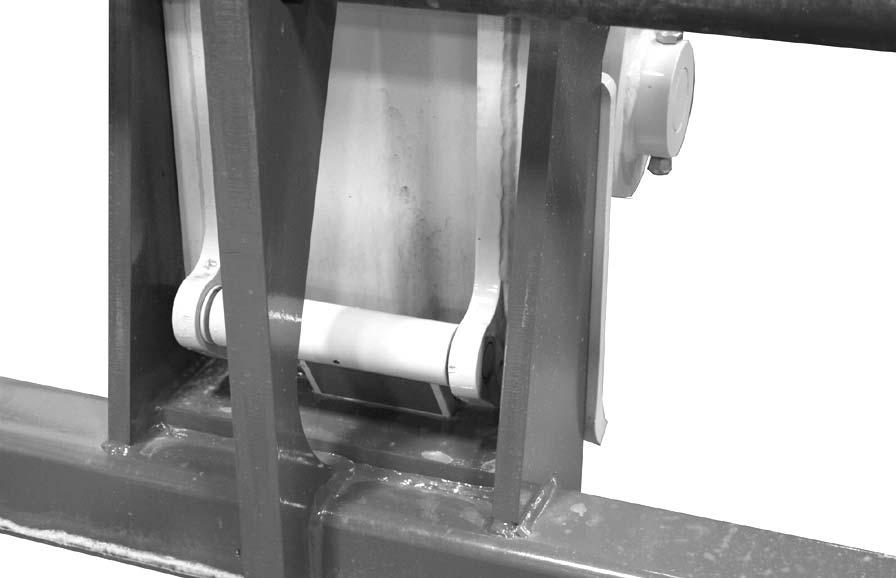
The proper sequence for correct machine operation is to always engage the parking brake switch before shutting off the engine; and to disengage the parking brake ONLY after the engine is running. In an emergency however, if it becomes necessary to stop movement, activate the parking brake switch to “ON.”
Changing Attachment Tools
The Telescopic Handler boom nose will accept Gehl Quick-attach™ System attachment tools. The Quickattach™ System has a quick-release hookup and locking mechanism for mounting framing-type or masonry-type attachment tools to the boom nose.
Attaching Procedure
To pick up an attachment tool, proceed as follows:
1.Raise the boom slightly, extend it two to three feet (600 to 900 mm) for better visibility, and tilt the tool carrier forward.
2.Align the tool carrier squarely with the back of the attachment tool.
3.Slowly extend the tool carrier and lower the hooks under the attachment tool hookup bar.
Quick-attach System Tilted Forward for Hookup
4.Tilt the tool carrier back so that the lock plate engages the attachment tool as shown below. This secures the attachment tool to the Quick-attach™ System. Verify the attachment tool is properly secured by tilting the tool sufficiently forward such that it does not hinge away from the tool carrier.
5.For an attachment tool with auxiliary hydraulics, connect the hoses to the quick-disconnect connectors on the boom nose.
Attachment Tool Shown Locked to Quick-attach System
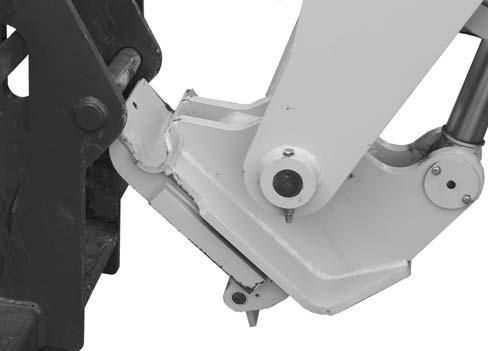
Detaching Procedure
To detach the attachment tool, proceed as follows:
1.Raise the boom slightly and extend it two to three feet (600 to 900 mm) for better visibility. Lower the boom until the attachment tool is approximately 12” (0.3 m) off the ground.
2.Tilt the carrier rearward as far as it will go. Once the carrier is tilted back all the way, perform the Mandatory Safety Shutdown Procedure (Safety chapter, page 11).
3.With the engine off, leave the operator’s station and manually raise the lock spring and flip the lock plate up and outward at least 180° a shown so it is in position to re-lock onto the next attachment tool.
Attachment Tool
Shown Unlocked for Release from Quick-attach System
Quick-attach System Detaching Detail
4.Tilt the Quick-attach™ System forward to allow the attachment tool to roll out, then lower the boom so that the hook ears clear the hookup bar on the attachment tool.
NOTE: One side of the lock plate has a bright red decal to indicate the unlocked position.
5.If the attachment tool has auxiliary hydraulics, disconnect the hoses from the quick-disconnects on the boom nose.
6.Start the engine and roll the Quick-attach™ System forward. Slowly back the machine until the attachment tool is free from the boom nose.
Warning
Modifications, alterations to, or use of attachment tools not authorized by Gehl (or the manufacturer) in writing can void warranty and cause machine damage and/or serious personal injury or death.
SELF-LEVELING
The machine is equipped with a hydraulic self-leveling feature. This feature is designed to keep the attachment tool level while the boom is being raised.
Machine Operation With Solid Rubber Tires
Solid rubber tires are designed for intermittent service and limited running distances. The Working Day Average Speed should not exceed 3 mph at an average load of 75% of maximum capacity. Telehandlers equipped with solid rubber tires should not be used in applications requiring speeds over 15 mph, or continuous journeys over 1 mile when loaded at or above 50% of capacity. In the event an application requires vehicle speeds over 15 mph, excessive roading, or driving extended distances while loaded, Gehl recommends the use of other approved tire options.
General Machine Operation
Check the Telescopic Handler to be sure all systems are in good operating condition. Perform the following steps before starting the machine the first time each day:
1.Check the engine oil, coolant, transmission oil and hydraulic oil levels.
2.Make sure weekly lubrication has been done.
3.Visually inspect for leaks, broken or malfunctioning parts. Make sure all caps, covers and safety shields are in place.
4.Check tires for cuts, bulges, nails, correct pressure, loose wheel nuts, etc.
5.Inspect the work area. Be sure you know where you will make load pickups, placements, lifts, and turns. Look over the terrain of the jobsite for holes, obstacles, slippery surfaces, and soft or deep mud.
6.Check clearances of ramps, doorways and passageways. Check overhead clearances if you will travel and place loads near power or telephone lines or other obstructions.
7.When traveling unloaded, tilt forks back and elevate boom as low as possible to obtain visability around the machine.
If the machine is found to be in need of repair or in any way unsafe, or contributes to an unsafe condition, the matter must be reported immediately to the user’s designated authority. The machine should not be operated until it has been restored to a safe operating condition.
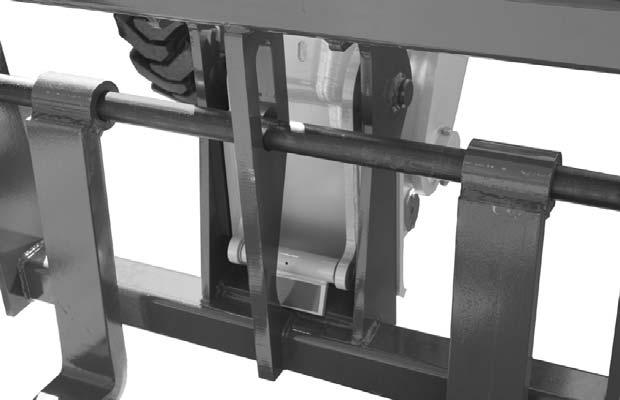
Warning
Exhaust fumes can kill. Ensure proper ventilation when starting indoors or in enclosed areas.
Use proper hand-holds, NOT the steering wheel or control levers as handholds when mounting and dismounting.
NEVER operate the machine with safety guards or covers removed.
Over-inflated tires can explode and cause injury or death. Tire repairs MUST be made only by authorized personnel using proper tools and equipment.
Operate the travel controls gradually and smoothly when starting, stopping, turning and reversing direction.
Grade and Slope Precautions
The Telescopic Handler complies with industry stability test requirements and is stable when properly operated. However, improper operation, faulty maintenance, and poor housekeeping can contribute to a condition of instability.
The amount of forward and rearward tilt to be used is governed by the application. Although use of maximum rearward tilt is allowable under certain conditions, such as traveling with the load fully lowered, the stability of the machine, as determined by the industry standard tests, does not encompass consideration for excessive tilt at high elevations, or the handling of offcenter loads.
Only handle loads within the capacity limits of the machine, and which are stable and safely arranged. When attachments are used, extra care should be taken in securing, manipulating, positioning and transporting the load.
Grade Limits
NOTE: Grade limits are based on ANSI/ITSDF standard B56.6-2005.
The telescopic handler meets or exceeds the safety standard (ANSI/ITSDF B56.6) stability limits for rough terrain forklifts. The stability tipping limits cover specific, controlled test conditions, which are extremes, and which are not intended to be achieved during normal worksite operations. The following specifications are provided only as information to the operator, and must not be used as a guideline for operating the telescopic handler. For safe operation, always follow the instructions and warnings provided in this manual.
Warning
DO NOT level the frame with the boom raised or extended. Only level the frame while stopped, and with the boom fully retracted, and the attachment tool raised just enough to clear the ground.
1.DO NOT place or retrieve loads on an up or down slope or grade that exceeds 7% or 4°.
2.DO NOT travel up or down a grade or slope that exceeds 22% or 12° while loaded.
3.DO NOT place or retrieve loads on a side hill with a slope or grade that exceeds 12% or 7°. Regardless of the terrain or position of the wheels, the FRAME MUST BE LEVEL, as indicated by the frame angle indicator on the ROPS/FOPS crossmember.
4.DO NOT travel across a side hill that exceeds 18% or 10° grade. Regardless of the terrain or position of the wheels, the FRAME MUST BE LEVEL, as indicated by the frame angle indicator on the ROPS/FOPS crossmember. The attachment tool MUST be maintained at the “carry” position with the boom fully retracted, and attachment tool at minimum ground clearance.
When ascending or descending grades in excess of 5% or 3°, the machine should be driven with the load upgrade. An unloaded machine should be operated on all forward grades with the load handling attachment tool downgrade, tilted back if applicable, and raised only as far as necessary to clear the road surface.
On grades, ramps and inclines, use extreme caution and avoid turning if possible. Normally travel straight up and down the slope.
Traffic Flow Patterns
Know and understand the traffic flow patterns of your jobsite. Know all Telescopic Handler hand signals for safety. Utilize signal persons and be sure you can see the signal person and acknowledge the signals given.
When ramps must be used in transporting loads with the machine, the following shall be the minimum widths for safe travel:
Compacted dirt, gravel, etc.12 ft. (3.6 m)
Woodboard, concrete, etc.10 ft. (3.0 m)
Permanent aisles, roadways, passageways, floors and ramps should be marked or defined in some fashion. Permanent or temporary protrusion of loads, equipment, material and construction facilities into the usual operating area should be guarded, clearly and distinctively marked, or clearly visible.
Maintain a safe distance from the edge of ramps, platforms and other similar working surfaces.
Controlled lighting of adequate intensity should be provided in operating areas. Where operating conditions dictate, the operator/user is responsible for having the machine equipped with lights.
Provisions should be made to prevent trucks, semitrailers and railroad cars from being moved during loading and unloading. Wheel stops, parking brakes, or other positive holding means should be used to prevent movement during loading and unloading.
DO NOT move railroad cars and trailers with the Telescopic Handler.
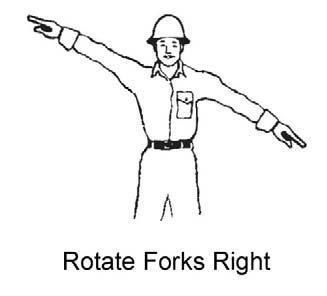
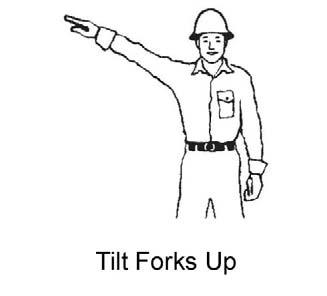
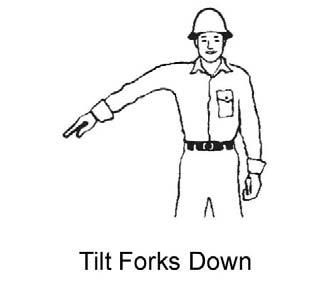
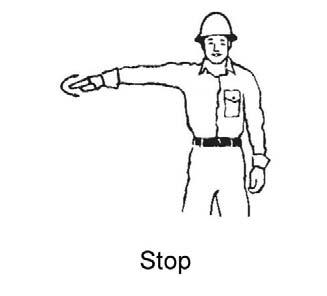
DO NOT use the boom and attachment for leverage to push the machine out of mud.
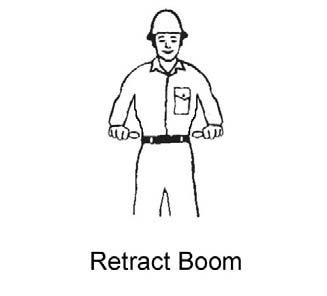
IMPORTANT: DO NOT lower boom at high engine speed when attachment tool is at maximum rearward tilt. Damage to slave cylinders may result.
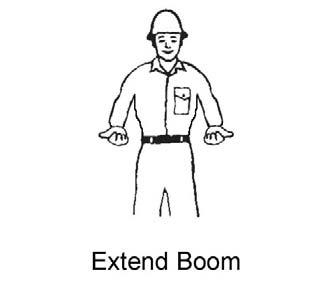
General Load Handling

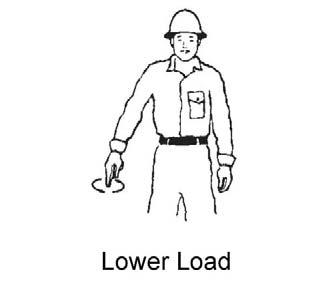
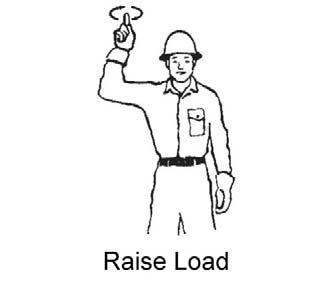
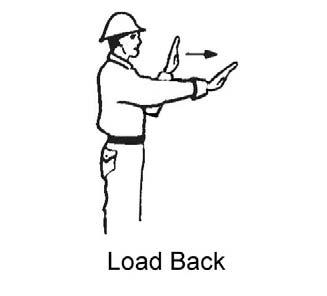
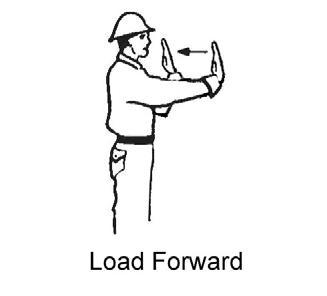
NEVER operate controls except from the operator’s seat. NEVER jerk or use fast movements. Avoid sudden stops, starts and changes in direction.
Operation of the hydraulic system depends on engine speed and the distance the controls are moved. When operating these controls it is important to develop a technique called “feathering.” Feathering the control means starting the desired motion by moving the control a small distance away from neutral. Then, after movement has started, the control can be eased to full travel. Use the same feathering technique to slow and stop the motion.
Warning
Excessive speed can be hazardous. ALWAYS exercise caution and good judgement while operating the machine.
ALWAYS maintain a safe distance from electric power lines and avoid contact with any electrically charged conductor and gas line. It is not necessary to make direct contact with a power line for power to ground through the structure of the machine. Keep the boom and load at least 10 ft. (3 m) from all power lines. Accidental contact with a power line or rupture of a gas line can result in electrocution or an explosion. Contact the “Call Before You Dig” referral system number at 8-1-1 in the U.S., or 888-258-0808 in the U.S. and Canada, to locate any underground utility lines BEFORE starting to dig.
Keep all body parts inside the operator’s station while operating the machine. BE SURE of clearance for the attachment tool when turning, working around buildings, etc.
Turning corners too fast can tip the machine, or cause a load to slide off the attachment. Sudden slowing or stopping of the machine may cause the load to fall off the attachment tool.
Be certain you can control both speed and direction before moving. Always place the machine in neutral and set the parking brake before raising or extending the boom. NEVER drive the machine up to someone standing in front of the load.
NEVER leave the operator’s station without first lowering the attachment tool to the ground. Then set the parking brake, place controls in neutral, shut off engine and remove the key. AVOID parking the machine on a slope, but if necessary, park across the slope and block the tires.
Load Capacity and Reach
The machine has flip-charts in the operator’s station that provide, at a glance, the load capacity limits at various positions of attachment tool extension and elevation. A set of the load zone charts is reproduced at the end of this manual for reference.
A typical load zone chart is shown on this page. The scale on the left indicates height in feet above the ground level. The scale on the bottom shows the distance in feet from the front of the machine. The arc lines noted by the numbers “1” through “5” correspond with the position extension markers on the operator side of the intermediate boom section.
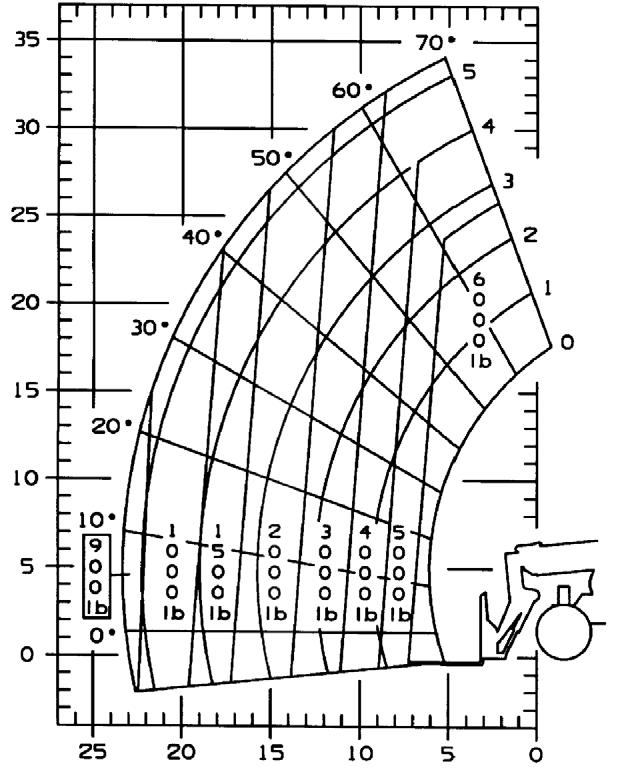
The following example illustrates proper use of the load zone charts for the Telescopic Handler:
Example: The operator, using a standard carriage attachment tool, wants to raise a 2000 lb. load 20 feet high, and can only get to within 15 feet of the load placement point. Can it be done within the capacity of the machine?
Analysis: See “Typical Load Zone Chart”.
Projecting up from the 15-foot reach mark on the horizontal axis to intersect a line through the 20-foot height mark on the vertical axis shows that a load up to 2000 lb. can be placed in that zone.
During placement, the operator should observe when the boom extension mark number “4” on the boom is visible and stop further extension. The operator knows the maximum safe extension distance with the 2000 lb. load has been reached.
Warning
NEVER exceed the rated operating capacity of the Telescopic Handler as shown on the load zone charts.
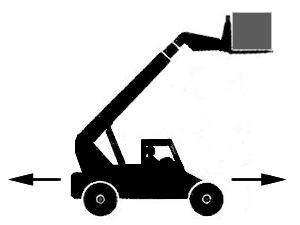
HANDLING NON-SUSPENDED LOADS
Picking Up the Load
Inspect the load before picking it up. If it appears unstable, DO NOT attempt to move it. DO NOT attempt lifting double-tiered loads, or straddling sideby-side pallets with one on each fork. NEVER add extra unauthorized counterweights to the machine.
Approach the load slowly and squarely with the machine straight and level. Adjust the space between forks, if necessary. Engage the load equally on the forks until the load touches the carriage backrest. Tilt the forks back to position the load for travel.
Warning
Operating conditions such as slopes or soft ground can reduce the machine’s safe operating capacity. Exceeding the capacity when raising or extending the boom will cause the machine to tip forward.
Carrying the Load
If the load obstructs your view, get someone to direct you. Maintain ground speeds consistent with ground conditions and that permit stopping in a safe manner.
Warning
NEVER travel with the boom above the carry position (attachment tool should be at minimum ground clearance). Boom should be fully retracted.
Use lower gear when traveling down an incline. NEVER coast with the transmission in neutral. Travel up and down grades slowly.
DO NOT operate the machine on a slope or grade that exceeds 22% or 12o.
Load Elevation and Placement
For ground level load placement, be sure the area under the load and around the machine is clear of equipment and personnel. Lower the load to the ground, tilt the forks to the horizontal position, and then carefully back away to disengage the forks from the load.
For elevated or overhead placement, bring the machine as close as possible to the landing point, and then:
1.Level the machine BEFORE raising the load. Use extreme caution for high placement. Be sure personnel are clear of the area where the load or the machine could fall or tip.
2.Set the parking brake, hold the service brake pedal fully applied and slowly raise the load, maintaining a slight rearward tilt to cradle the load.
3.As the load approaches the desired height, feather the boom control at minimum speed until the load is slightly higher than the landing point.
4.Continuing the feathering technique, lower the load into place.
5.Free the forks from the load by alternately retracting and raising the boom. If this process is not possible, very slowly and carefully reverse the telescopic handler to free the forks from the load.
6.Lower the forks to travel height.
Warning
The machine becomes less stable as the load is raised higher.
NEVER use frame leveling to position an elevated load. Always lower the load to the ground and reposition the machine.
If a hydraulic boom circuit hose should break with the boom up, shut down the machine. DO NOT attempt to bring down the boom or make repairs. Call your Gehl dealer immediately.
As lift height increases, depth perception decreases. High elevation placement may require a signal person to guide the operator.
DO NOT ram the lift cylinders to the end of the stroke. The resulting jolt could spill the load.
A jib or truss boom should ONLY be used to lift and place loads when the machine is stationary and the frame is level. Transporting suspended loads must ALWAYS be done slowly and cautiously, with the boom and load as low as possible. Use taglines to restrict loads from swinging, to avoid overturn.
Handling Suspended Loads
Determine the weight and load center of the load to be handled. Refer to the telehandlerload chart to determine if the load can safely be handled.
NOTE: Refer to the standard carriage load chart when using the boom mounted hook.
Warning
NEVER exceed the rated operating capacity of the telehandler as shown on the load zone charts.
Warning
Operating conditions can reduce the telehandler’s safe operating capacity. Exceeding the capacity when raising or extending the boom will cause the telehandler to tip forward.
Picking Up Suspended Load
1.Rigging should be in good condition and rated for the load being lifted.
2.Rigging should comply with OSHA regulation §1910.184, “Slings,” or §1926.251, “Rigging equipment for material handling.”
3.Be sure the rigging equipment is clear of any part of the machine or machine attachment before lifting the load.
4.Avoid lifting double-tiered or any unstable loads.
5.Only lift loads vertically and clear from any adjacent obstacles. Never drag the load horizontally.
6.Use multiple lift points and taglines to restrain the load from swinging or rotating.
Carrying Suspended Load
1.Rigging between the load and attachment should be as short as possible to reduce boom height.
2.Do not raise the load more than 12 inches (305 mm) above the ground or raise the boom more than 45 degrees.
3.All telehandler movements should be performed slowly and cautiously to prevent load swing. Avoid abrupt movement. Do not exceed walking speed.
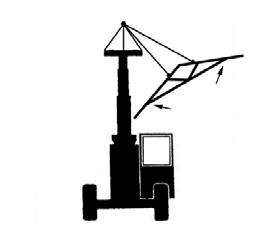
4.Use a signal person anytime the load restricts the operators view or assistance is required. The signal person should remain in contact (verbally or visually) with the operator at all times until the load is placed.
Ground Level Suspended Load Placement
1.Be sure the area under the load and around the telehandler is clear of equipment and personnel.
2.Lower the load to the ground till load is stationary and the rigging is loose from the load. Have signal person disconnect the rigging from the load.
3.Raise boom enough to clear the rigging from the load before backing the telehandler away from the load.
Elevated Suspended Load Placement
1.Bring the telehandler as close as possible to the landing point.
2.Level the telehandler BEFORE raising the load. Use extreme caution for high placement. Be sure personnel are clear of the load landing area.
3.Set the parking brake, shift the transmission into neutral,hold the service brake pedal fully applied and slowly raise the load.
4.As the load approaches the landing point, feather the boom control at minimum speed until the load is just above the landing point.
5.With the assistance of a signal person, continue the feathering technique to lower the load into place.
Warning
NEVER place the signal person between the load and the telehandler or other stationary objects.
6.Once the load is stationary on the landing point and the rigging is loose from the load, have the signal person disconnect the rigging from the load.
7.Raise boom enough to clear the rigging from the load. Slowly and carefully, reverse the telehandler till the rigging is clear of the load.
8.Lower the boom to travel height.
Installing a Personnel Work Platform (PWP)
Warning
The machine must not be used to lift or carry personnel or be fitted with any form of personnel work platform unless fitted with the optional PWP System.
If fitted with the PWP System, the Mandatory Work Platform Safety Rules (p. 17) must be followed at all times while lifting personnel.
1.Center the forks on the carriage, spaced apart to match the distance required to engage the PWP.
2.After the forks are fully engaged in the PWP, secure the PWP to the forks. This can be accomplished by means of a retaining pin behind the heel of the forks, as shown.
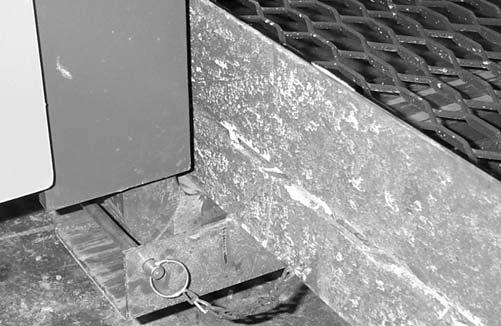
3.Secure the forks from pivoting upward in case the PWP is lowered onto an obstruction. This can be accomplished by using the chain supplied with the PWP to secure the lower portion of the PWP to the bottom of the carriage, as shown below.
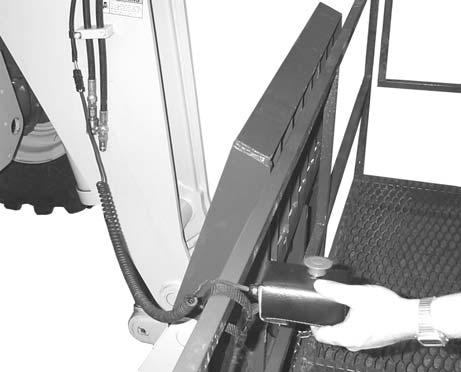
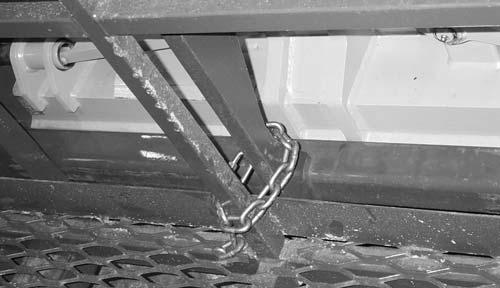
Warning
The PWP must meet ANSI/ITSDF B56.6-2005, Section 8.24. (See page 18 in the Safety chapter for PWP design requirements.) If the PWP being used does not offer means to secure the PWP to the forks and to secure the forks from pivoting, as shown in steps 2 and 3, then an alternate method must be used.
4.Connect the coiled wire from the remote shutdown switch to the connector on the end of the boom. Secure the remote shutdown switch to the PWP using the strap attached to the switch, as shown below.
Electrical Connection
PWP
Remote Shutdown Switch
Remote Shutdown Switch with Coiled Wire Connector
5.Secure the lanyard from the body harness to the PWP or the boom. Each person in the PWP should have a body harness with a lanyard attached to the PWP.
Elevating Personnel
The Telescopic Handler is primarily intended for use as a material handler. It should only be used to elevate personnel if it is equipped with the (optional) PWP System when there is no other practical option. If this machine is to be used to elevate personnel, then use only an approved work platform, lift personnel only with the PWP System activated, and follow the “Mandatory Work Platform Safety Rules” (p. 17 Safety chapter).
If the Telescopic Handler is equipped with a PWP System and is to be used for elevating personnel, the system must be activated, by the "PWP System" mode switch, which is located in the instrument and switch panel. To activate the system, press the top of the PWP rocker switch, apply and hold the service brakes on for three or more seconds. The system is activated when the lamp in the PWP rocker switch is on continuously.
NOTE: If the light is flashing, apply the service brakes until the light stops flashing.
Warning
ALWAYS check the PWP System for proper operation prior to use. (See page 60 for PWP System checking procedure.)
When the PWP System is active:
l transmission is de-clutched into Neutral, l parking brake is applied, l auxiliary hydraulic and carriage tilt and swing functions are disabled, l machine inclination sensor is activated, with the result that the Telescopic Handler must be level laterally (side-to-side) and longitudinally (front-toback) to within the factory pre-set limits before the boom control joystick will function, and l remote shutdown switch is activated, meaning that the switch must be connected and in the “on” position for the boom control joystick to function. Pressing the shutdown switch will disengage the boom control joystick, and stop all platform movement. The remote shutdown switch box is supplied with a coiled electrical cable that must be connect- ed to the outlet on the front of the innermost boom section near the carriage. The switch must be accessible by the platform personnel at all times when the platform is to be moved.
To de-activate the PWP System, apply and hold the service brakes on for three or more seconds, and press the bottom of the PWP System rocker switch. The system is de-activated when the lamp in the PWP System rocker switch is off.
NOTE: If the lamp in the PWP system rocker switch is flashing, apply the service brakes until the lamp goes off.
Warning
In an emergency, if the platform worker has activated the remote shut-off switch and then is not able to re-activate the switch, such as if the worker fainted, then the Telescopic Handler operator is permitted to turn off the PWP System to regain control of the boom functions, in order to lower the work platform and come to the aid of the worker. But, understand this is only permitted in case of an emergency. Otherwise, the PWP System must be used at all times when there are workers on the platform. This is the only exception!
Road Travel
For short distance highway travel, attach a SlowMoving Vehicle (SMV) emblem (purchased locally) to the rear of the Telescopic Handler. For highway operation, obtain and install an amber flashing beacon.
NOTE: ALWAYS follow ALL state and local regulations regarding the operation of equipment on or across public highways. Whenever there is an appreciable distance between jobsites, or if driving on public highway is prohibited, transport the machine using a vehicle of appropriate size and capacity.
Transporting Between Jobsites
ALWAYS abide by the following recommended procedures and guidelines when using ramps to load the machine onto (and unload it from) a truck or trailer. Failure to heed can result in damage to equipment and serious personal injury or death!
Tie-down eyes are provided for inserting chains through to secure the machine during transporting.
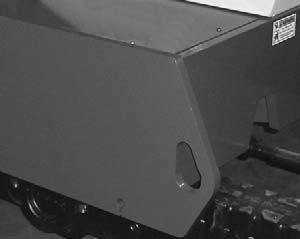
Unloading Machine Using Ramps
NOTE: A matched pair of ramps is required.
Repeat steps 1 through 5 and proceed as follows to unload the machine:
6.Remove the tie-down chains/cables.
7.If necessary, adjust the machine so that the wheels are in line and centered with the ramps.
8.Slowly (at the lowest engine speed possible) and carefully drive the machine down the ramps.
Loading Machine Using Ramps
Warning
NEVER adjust travel direction (even slightly) while traveling on the ramps. Instead, back down off the ramps, and then realign the machine with the ramps.
Warning
Ramp
NOTE: A matched pair of ramps is required.
1.The ramps MUST be of sufficient strength to support the machine. The use of strong steel ramps is recommended, as well as center supporting blocks.
2.The ramps MUST be firmly attached to the truck or trailer bed with NO step between the bed and the ramps.
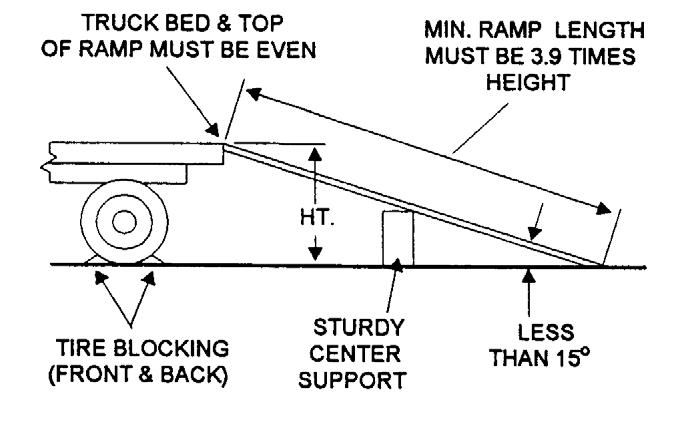
3.The incline of the ramps MUST be less than 15 degrees. For a four-foot high truck bed, ramp length must be at least 16 feet (4.9 m) long.
4.Ramp width MUST be at least 1-1/2 times the tire width.
5.Block the front and rear of the tires on the truck or trailer. Engage the parking brake.
6.Position the machine with the boom facing toward the front of the truck or trailer so that it is straight in line with the ramps.
7.Slowly (at the lowest engine speed possible) and carefully drive the machine up the ramps.
8.Secure the machine to the bed of the truck or trailer with tie-down chains/cables.
NEVER transport the machine with the boom raised or extended. BE SURE to secure the machine to the truck or trailer bed using chain and binders or steel cables, to prevent any movement while transporting.
Theft Deterrents
Gehl Company has recorded all major component part numbers and serial numbers. Users should take as many of the following actions as possible to discourage theft, to aid in the recovery of the machine in the event it is stolen, and to reduce vandalism:
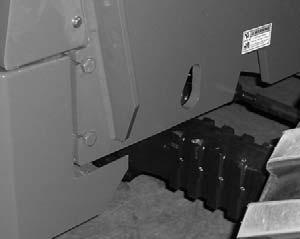
1.Remove keys from unattended machines.
2.Attach, secure, and lock all anti-vandalism and anti-theft devices on the machine.
3.Lock doors of cabs when not in use.
4.Inspect the gates and fences of the equipment storage yard. If possible, keep machines in well-lighted areas. Ask the local law enforcement agency to make frequent checks around the storage and work sites, especially at night, during weekends, and on holidays.
5.Report any theft to your dealer and insurance company. Provide the model and serial numbers. Request your dealer to forward this information to Gehl Company.
General Information
Chapter 7 LUBRICATION WARNING
NEVER lubricate or service this unit when any part of the machine is in motion. ALWAYS exercise the MANDATORY SAFETY SHUTDOWN PROCEDURE (p. 11, SAFETY chapter) before lubricating or servicing this equipment.
NOTE: The Maintenance chapter (Chapter 10) in this manual has provisions for recording the dates and hourmeter readings after lubrication or other service has been performed; use those spaces to keep a log for maintaining a current service interval record. Proper routine lubrication is an important factor in preventing excessive part wear and early failure.
Lubricants
The chart on this page lists the locations, temperature ranges and recommended types of lubricants to be used when servicing the machine. Refer to the separate engine manual for additional information regarding recommended engine lubricants, quantities and grades required.
NOTE: Refer to Operator Services topic in the Service and Storage chapter of this manual for detailed information regarding periodic checking and replenishing of lubricants.
Transmission Oil
Temp. Range -25°F - 75°F (-32°C - 24°C)
Use Dexron® II or equivalent
Factory filled with CHS Cenex Auto Gold D/M
Temp. Range 0°F - 100°F (-18°C - 38°C)
Use Allison C-4 30W or equivalent
Capacity: 24 quarts (23 liters)
Brake System
Use Multi-ATF Dexron® II/III or equivalent
Hydraulic System Reservoir
Use an oil that contains anti-rust, anti-foam and anti-oxidation additives and conforms to ISO VG46/VG32.
Factory filled with CHS Cenex Indol
Alternative oil: Mobil DTE 15M or equivalent
Capacity: 35 gallons (133 liters)
Engine Crankcase Oil
Ambient TemperatureGrade*
-22°F - 86°F(-30°C - 30°C)SAE 5W-30
-22°F - 104°F(-30°C - 40°C)SAE 5W-40
-4°F - 86°F(-20°C - 30°C)SAE 10W-30
-4°F - 104°F(-20°C - 40°C)SAE 10W-40
5°F - 104°F(-15°C - 40°C)SAE 15W-40
IMPORTANT: Refer to the Engine Operator’s Manual for specific oil recommendations and additional information.
*API Service Classification: CJ-4
Capacity: 9.5 quarts (8.9 liters)
Diesel Fuel
Use only ultra low sulfer (ULSD) diesel fuel with a maximum of 15 PPM sulfer content specified to EN590 or ASTM D975.
Engine Coolant
IMPORTANT: Use an ethylene glycol based Extended Life Coolant and quality water mixture suitable for heavy duty diesel engines. Coolant should be a phosphate-free, silicate-free, nitrite-free and borate-free formula with corrosion inhibitors to provide wet sleeve liner cavitation and corrosion protection of all cooling system metals.
Factory filled with: FINAL CHARGE 50/50
PRE-DILUTED Global Extended Life Coolant/Antifreeze.
Axle Gear Oil
Factory filled with CHS Cenex Qwiklift HTB
Alternative oil: MobilFluid® 424 or equivalent
Differential capacity: 9.6 quarts (9.0 liters)
Planetary capacity: 0.6 quarts each (0.5 liters)
All Grease Fittings
Use No. 2 lithium-based grease
Replacement Filter Chart
Greasing
Refer to the illustrations and listings for fitting locations. Wipe dirt from the fittings before greasing them to prevent contamination. Replace any missing or damaged fittings. To minimize dirt build-up, avoid excessive greasing.
Basic Machine Grease Fittings Locations
Every 50 Hours (or weekly)
Refer to the illustration on the facing page for locations.
